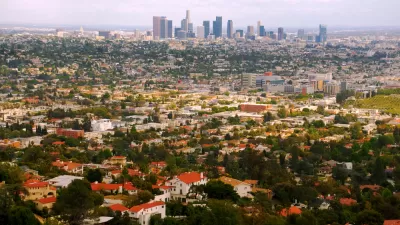What began as Google buses, transporting highly paid engineers from San Francisco to Silicon Valley, has transformed into multi-company fleets serving white- and blue-collar workers in the 3,000-square-mile Northern California megaregion.

"Tech companies have grown tight-lipped about the specifics of their shuttle programs in the wake of high-profile protests in San Francisco," reports Lauren Hepler for Protocol.
But Protocol was able to locate enough stops for company shuttles to confirm that some tech shuttles now drive all the way out to the Central Valley, an agricultural hub once a world away from the tech boom on the coast.
Hepler's reporting on super-commuting in the Northern California megaregion is extensive. What began with Google and Facebook shuttles now includes Tesla, Apple, Netflix, LinkedIn, Genentech, and others.
They all now offer shuttle service to at least the extended suburbs of the East Bay, according to interviews and reports Protocol consulted. Their longest routes now stretch north across the Golden Gate Bridge, south to the surf town of Santa Cruz, and east to the Central Valley — a total service area approaching 3,000 square miles.
Tesla shift workers
Hepler's deep dive begins at 2:30 a.m. in Salida, a small town in Stanislaus County in the San Joaquin Valley, where Tesla employees line-up to catch a chartered bus.
Next stop is 11 miles away in Manteca and then it's another 55 miles to Fremont on the San Francisco Bay, where — an hour and a half hour later — the 4 a.m. shift at the Tesla factory starts.
Tesla did not respond to multiple requests for comment, but visits to shuttle stops and interviews on the ground show its network of buses stretches to the eastern limits of a new megaregion. These buses move employees to Tesla's 15,000-person Fremont factory, where pay starts at around $19 an hour — not enough to afford Fremont's average $2,500 rent.
Housing nexus
Hepler's focus is primarily on transportation, writing about super-commuting via tech buses, which she calls tech shuttle sprawl. An astounding one-third of the employees at Google's main Silicon Valley campuses take a shuttle each day. However, it doesn't take long for the housing connection to surface.
High tech salaries have driven up housing prices in Silicon Valley, San Francisco and the East Bay, forcing white- and blue-collar workers alike to move farther away from their jobs. The crisis is compounded by anti-development politics that make it hard to build new housing and patchwork public transit systems that make it difficult for commuters to get to work without driving.
"That just tells you the story of the Bay Area," said Russell Hancock, president and CEO of regional think tank Joint Venture Silicon Valley. "We're going to be in these farther-flung places, and that's our reality because we're not going to be able to create affordable housing."
Super-commuting via public transit
For commuters who don't work for tech companies that offer their employees regional shuttles but opt to live in the Bay Area exurbs, commuting is more complex, and expensive. Hepler describes two workers' commutes to the Bay Area from Tracy, the second-largest city San Joaquin County—one who takes a Tesla shuttle to Fremont, and another who takes a San Joaquin Regional Transit District commuter bus to connect with to an East Bay Bart station, a $158 monthly cost not counting the BART and MUNI fares to the job in San Francisco.
Others take the bike-friendly Altamont Corridor Express commuter rail, which offers four morning trips every weekday from Stockton to San Jose ($386 monthly), and four back in the late afternoon and evening.
However, these bus-and-rail commuters are the exception. Most super-commuters continue to drive, clogging the freeways, which explains one of the projects mentioned in the article, the $1.8 billion Valley Link rail project.
Related in Planetizen:
-
Housing, Transit Crunches Collide in the Bay Area, August 25, 2017
-
Is Your Commute Killing You? October 29, 2013
-
Extreme Commuting Still Commonplace, April 7, 2010
Hat tip to Paul Plathe.
FULL STORY: Silicon Valley's new extreme: The 2:30 a.m. tech bus from Salida

Alabama: Trump Terminates Settlements for Black Communities Harmed By Raw Sewage
Trump deemed the landmark civil rights agreement “illegal DEI and environmental justice policy.”

Study: Maui’s Plan to Convert Vacation Rentals to Long-Term Housing Could Cause Nearly $1 Billion Economic Loss
The plan would reduce visitor accommodation by 25% resulting in 1,900 jobs lost.

Planetizen Federal Action Tracker
A weekly monitor of how Trump’s orders and actions are impacting planners and planning in America.

Waymo Gets Permission to Map SF’s Market Street
If allowed to operate on the traffic-restricted street, Waymo’s autonomous taxis would have a leg up over ride-hailing competitors — and counter the city’s efforts to grow bike and pedestrian on the thoroughfare.

Parklet Symposium Highlights the Success of Shared Spaces
Parklets got a boost during the Covid-19 pandemic, when the concept was translated to outdoor dining programs that offered restaurants a lifeline during the shutdown.

Federal Homelessness Agency Places Entire Staff on Leave
The U.S. Interagency Council on Homelessness is the only federal agency dedicated to preventing and ending homelessness.
Urban Design for Planners 1: Software Tools
This six-course series explores essential urban design concepts using open source software and equips planners with the tools they need to participate fully in the urban design process.
Planning for Universal Design
Learn the tools for implementing Universal Design in planning regulations.
Caltrans
Smith Gee Studio
Institute for Housing and Urban Development Studies (IHS)
City of Grandview
Harvard GSD Executive Education
Toledo-Lucas County Plan Commissions
Salt Lake City
NYU Wagner Graduate School of Public Service




























